Tariffs imposed by the Trump administration collected an estimated $958 million in revenue from selected agricultural inputs from February to October of 2025, according to North Dakota State University's monthly…
USDA Updates U.S. Ag Export Forecast Amid NAFTA Worries
In fiscal year 2017, U.S. agricultural exports totaled $140.5 billion, representing the third-highest level on record. In its quarterly export forecast in August, USDA indicated that fiscal year 2018 agricultural exports were projected at $139.0 billion. However, in its latest quarterly forecast, released late last month, USDA increased the fiscal year 2018 export projection by $1.0 billion. Today’s update examines the latest export forecast in more detail, and looks briefly at recent NAFTA news items pertaining to agriculture, including a report from the Nebraska Farm Bureau.
USDA- FY 2018 Forecast: Corn, Soybeans
On November 30th, USDA indicated that, “Fiscal Year 2018 agricultural exports are projected at $140.0 billion, up $1.0 billion from the August forecast, largely due to expected increases in corn and distiller’s dried grains with solubles (DDGS). Higher corn volumes and unit values and strong demand for DDGS are largely responsible for driving grain and feed exports up $1.0 billion to $29.4 billion. Soybean export volumes continue to set records, raising the soybean forecast $200 million to $24.1 billion, which offsets expected declines in soybean meal and oil.”
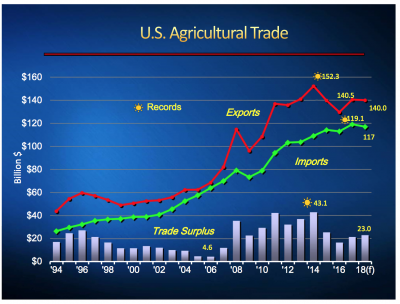
The USDA update explained that, “Fiscal year 2018 grain and feed exports are $29.4 billion, up $1.0 billion from the August forecast, due mainly to coarse grains and feeds and fodders. Corn exports are forecast at $8.5 billion, up $500 million on both higher volumes and unit values. These are supported by strong early-season sales and shipments, primarily to Mexico.
With sharply lower domestic sorghum supplies, Mexico is expected to boost corn imports to satisfy feed demand.
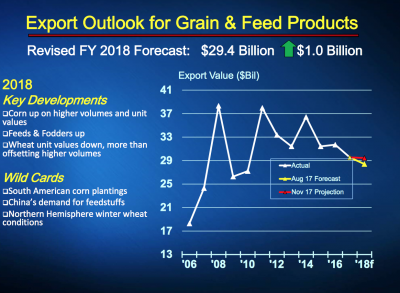
“Feeds and fodders are forecast at $7.5 billion, up $500 million on expectations of strong demand for distiller’s dried grains with solubles (DDGS). Wheat exports are forecast at $6.3 billion, down $100 million as lower unit values more than offset higher volume. Unit values are lower on pressure from abundant global supplies, especially in Russia. Volume is up on large sales to Iraq and the expectation that U.S. wheat will be more competitive later in the year.”
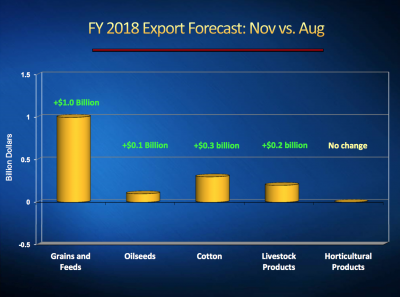
Turning to oilseeds, USDA pointed out that, “Oilseeds and products are projected up slightly to $33.1 billion as higher soybeans more than offset declines in soybean meal and oil. Record U.S. soybean production is driving record exports. Although unit values are lower on larger global supplies, these are expected to spur additional demand for U.S. soybeans, pushing total soybean export value up $200 million to $24.1 billion. Competition from South America and demand in China remain key drivers in the forecast.”
For more on the soybean export outlook, listen to this USDA radio clip (MP3- 30 seconds) featuring Warren Preston, USDA Deputy Chief Economist.
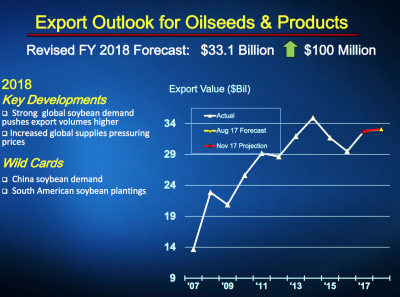
In response to the USDA trade projections, Secretary of Agriculture Sonny Perdue noted that, “Much of this expected success can be attributed to robust sales to our East Asian and North American trading partners. China is again shaping up to be our top market, led by continued strong soybean sales, while Canada and Mexico remain our second- and third-largest markets, respectively. We’re expecting exports to grow in the coming year to all of our top three markets.”
Nebraska Farm Bureau Releases NAFTA Report Amid Concerns of U.S. Withdrawal
An update on November 30th at AgWeb Online reported that, “As North American Free Trade Agreement (NAFTA) re-negotiations continue, farmers are growing increasingly concerned about the possibility President Donald Trump will pull out of the deal. Agriculture Secretary Sonny Perdue attempted to ease farmer concerns this week at the Ag Retailers Association meeting in Phoenix.
“‘I don’t know what will happen with NAFTA,’ he said. ‘I do believe the President wants a deal. He’s a tough negotiator, and if you’ve read his book, The Art of the Deal, he’ll take it to the brink sometimes. He knows the power of the ag economy, and he wants a growing, thriving healthy ag economy.'”
Sen. @JerryMoran says every indication points toward the Trump administration sending formal notice that it will withdraw from #Nafta (perhaps as a high-stakes negotiating tactic). https://t.co/wfHclEmzzV
— William Mauldin (@willmauldin) December 1, 2017
Meanwhile, in a radio interview late last month, Sen. Jerry Moran (R., Kans.) indicated that, “…[I] got very nervous when every indication seems to me to be that the administration is going to terminate NAFTA, then indicate that they have six months before it actually expires to get a better deal. In other words, using it as leverage. Maybe that works, but it makes me very nervous…”
Also, Paul Vieira reported on Monday at The Wall Street Journal Online that, “Canadian Prime Minister Justin Trudeau said Monday he was ready to forge ahead with formal talks toward a free-trade deal with China, but at ‘a proper pace’ and with assurances any pact addresses the environment, labor standards and gender rights.”
The Journal article noted that, “[Trudeau’s] comments to Canadian reporters traveling with him in China came after a meeting in Beijing with Chinese Premier Li Keqiang, in which the two leaders said they would continue to explore the feasibility of a bilateral free-trade pact but offered no timeline…Mr. Trudeau’s trip to China, with its heavy emphasis on trade, is being watched closely in light of the problematic state of talks to revamp the North American Free Trade Agreement. U.S. Trade Representative Robert Lighthizer has criticized a ‘lack of headway’ in the talks. The White House wants to make the terms of trade in the 23-year-old treaty more favorable to the U.S. through changes that Mexico and Canada have opposed.
A rapid Canadian move to launch formal trade talks with China would signal to the U.S. that Ottawa has other trading options available should Nafta collapse.
And Barbara Soderlin reported on Monday at the Omaha World-Herald Online that, “Withdrawing from a free-trade agreement with Canada and Mexico would cause long-term harm to Nebraska farmers and ranchers and put a big dent in the state’s economy, the Nebraska Farm Bureau said in a new report.”
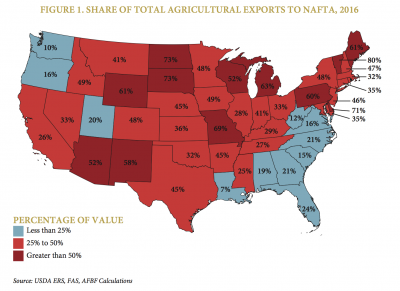
The World-Herald article added that, “‘While we understand the president wants to get the best trade deal possible, the idea of withdrawing from NAFTA is unfathomable,’ Nebraska Farm Bureau President Steve Nelson said. ‘Farm and ranch families are already working through a struggling agriculture economy and the loss of NAFTA would undercut recovery and more importantly cause long-term damage.’
“The report’s author, Nebraska Farm Bureau economist Jay Rempe, said NAFTA provides vital demand for key exports such as beef, pork, soybeans and corn.”





